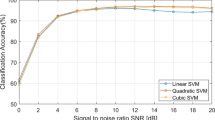Abstract
This study utilizes higher order spectrum in order to achieve satisfactory probability of correct classification of M-ary Frequency Shift Keying (MFSK) modulated signals even at low signal to noise ratios. MFSK modulated signals are characterized by a single feature, spectral centroid, which is defined as the centroid value of the diagonal vector of bispectrum matrix. It is observed that conventional K-means clustering is sufficient to achieve satisfactory modulation classification performance using this single feature. The parameters such as bandwidth and chosen FFT size which affect the correct classification ratio at a certain signal to noise ratio are analysed in order to optimize the performance of the proposed method.






Similar content being viewed by others
References
Wong, M. L., & Nandi, A. K. (2004). Automatic digital modulation recognition using artificial neural network and genetic algorithm. Elsevier Signal Processing, 84, 351–365.
Nandi, A. K., & Azzouz, E. E. (1998). Algorithms for automatic modulation recognition of communication signals. IEEE Transactions on Communications, 46(4), 431–436.
Adjemov, S. S., Klenov, N. V., Tereshonok, M. V., & Chirov, D. S. (2015). Methods for the automatic recognition of digital modulation of signals in cognitive radio systems. Moscow University Physics Bulletin, 70(6), 19–27.
Zhao, C., & Yang, W. (2013). Modulation recognition of MFSK signals based on multifractal spectrum. Wireless Personal Communications, Springer, 72, 1903–1914.
Kubankova, A., & Kubanek, D. (2011). Extended method of digital modulation recognition and its testing. Radio Engineering, 20(1), 25–30.
Bahloul, M. R., Yusoff, M. Z., Abdel-Aty, A., Saad, M. N. M., & Al-Jemeli, M. (2016). Modulation classification for MIMO systems: State of the art and research directions. Elsevier Chaos, Solitons and Fractals, 89, 497–505.
Chen, Y., Liu, J., & Lv, S. (2011). Modulation classification based on bispectrum and sparse representation in cognitive radio. In Thirteenth international conference on communication technology (pp. 250–253).
Ye, F., Chen, J., Li, Y., & Ge, J. (2016). MFSK signal individual identification algorithm based on bi-spectrum and wavelet analyses. KSII Transactions on Internet and Information Systems, 10(10), 4808–4824.
Alharbi, H., Mobien, S., Alshebeili, S., & Alturki, F. (2012). Automatic modulation classification of digital modulations in presence of HF noise. EURASIP Journal on Advances in Signal Processing, 2012, 1–14.
Li, R., Song, C., Song, Y., Hao, X., Yang, S., & Song, X. (2020). Deep geometric convolutional network for automatic modulation classification. Signal, Image and Video Processing, Springer, 14, 1199–1205.
Wang, Y., Gui, J., Yin, Y., Wang, J., Sun, J., Gui, G., et al. (2020). Automatic modulation classification for MIMO systems via deep learning and zero-forcing equalization. IEEE Transactions Vehicular Technology, 69(5), 1–6.
Tu, Y., Lin, Y., Hou, C., & Mao, S. (2020). Complex-valued networks for automatic modulation classification. IEEE Transactions Vehicular Technology, 69(9), 1–6.
Mihandoost, S., & Azimzadeh, E. (2020). Introducing an efficient statistical model for automatic modulation classification. Journal of Signal Processing Systems, Springer, 92, 123–134.
Subbarao, M. V., & Samundiswary, P. (2020). Performance analysis of modulation recognition in multipath fading channels using pattern recognition classifiers. Wireless Personal Communications, Springer, 115, 129–151.
Ara, H. A., Zahabi, M. R., & Ebrahimzadeh, A. (2021). Blind digital modulation identification using an efficient method of moments estimator. Wireless Personal Communications, Springer, 116, 301–310.
Wang, D., Zhao, X., & Zhang, Y. (2014). Extraction of signal waveform feature based on bispectrum. International Journal of Computer and Communication Engineering, 4(2), 81–89.
Nikias, C. L., & Mendel, J. M. (1993). Signal processing with higher-order spectra. IEEE Signal Processing Magazine, 10, 10–37.
Chua, K. C., Chandran, V., Acharya, U. R., & Lim, C. M. (2010). Application of higher order statistics/spectra in biomedical signals—A review. Elsevier Medical Engineering & Physics, 2010(32), 679–689.
Sanaullah, M. (2013). A review of higher order statistics and spectra in communication systems’. Global Journal of Science Frontier Research Physics & Space Science, 13(4), 1–21.
Bhalke, D. G., Rama Rao, C. B., & Bormane, D. S. (2014). Musical instrument classification using higher order spectra. International Conference on Signal Processing and Integrated Networks, 2014, 40–45.
Orhan, U., Hekim, M., & Özer, M. (2011). EEG signals classification using the K-means clustering and multilayer perceptrone neural network model. Elsevier Expert Systems with Applications, 2011(38), 13475–13481.
Duda, R. O., Hart, P. E., & Stork, D. G. (2000). Pattern classification. Hoboken: Wiley.
Park, C. S., Choi, J. H., Nah, S. P., & Jang, W. (2008). Automatic modulation recognition of digital signals using wavelet features and SVM. In Tenth international conference on advanced communication technology (pp. 387–390).
Avci, E., & Avci, D. (2008). The performance comparison of discrete wavelet neural network and discrete wavelet adaptive network based fuzzy inference system for digital modulation recognition. Elsevier Expert Systems with Applications, 35, 90–101.
Author information
Authors and Affiliations
Corresponding author
Ethics declarations
Conflict of interest
None declared.
Additional information
Publisher's Note
Springer Nature remains neutral with regard to jurisdictional claims in published maps and institutional affiliations.
Rights and permissions
About this article
Cite this article
Baris, B., Cek, M.E. & Kuntalp, D.G. Modulation Classification of MFSK Modulated Signals Using Spectral Centroid. Wireless Pers Commun 119, 763–775 (2021). https://doi.org/10.1007/s11277-021-08236-2
Accepted:
Published:
Issue Date:
DOI: https://doi.org/10.1007/s11277-021-08236-2




